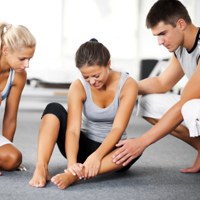The Mysteries of Injuries

|
Chiropractic Care, Injury Recovery, and Injury Prevention
|
|
Underlying causes of sports- and exercise-related injuries often involve complex biomechanical imbalances. A person may spend vast amounts of precious time and money trying to find effective therapy, but still may not achieve a permanent solution until they begin chiropractic care.
Chiropractic care specifically addresses biomechanical issues at their source by detecting, analyzing, and correcting imbalances in spinal joints and spinal muscles. The spinal column is the body's mechanical center. All efficient movement - involving the torso, pelvis, legs, and arms - begins with proper functioning of the spinal column.
By identifying and correcting various spinal imbalances, your chiropractor will help you recover from your injury faster and help you prevent new injuries in the future. The overall result is greater enjoyment of the time you spend exercising and greater benefit from new and improved levels of fitness.
|
A person with an exercise- or sports-related injury has many questions: When can I start exercising? When can I get back to my sport? What can I do to prevent this from happening again? The answers to these questions are relatively straightforward. But for some, injuries continue to happen. Which leads to the key question: Why did this happen to me?1,2
This is the hardest to answer. Some injuries may occur even when you're doing the things you're supposed to be doing. Sometimes you just have to shrug your shoulders and move on. But it's also very important to continue to try to discover the underlying causes.
If we dig deeper, we'll find that there are three main sources of training injuries: (1) under-preparation, (2) over-training, and (3) lack of focus or not paying attention.
Under-preparation means doing things you're not ready to do. People who have never done aerobic exercise go out and try to run five miles. People who have never done strength training go to the gym and try to lift weights that are too heavy. People who have never taken a yoga class go to one, like it, and then go every day for a week.
These exercise patterns can be dangerous, physically, and may directly lead to injury. A 16-year-old teenager has some leeway and can get away with making a variety of training errors. This may even be true for those who are in their mid-20s. But persons who are older need to train on a trajectory. Good principles to follow include starting slowly, starting with the basics, and making sure to include rest days in your training program. Build up your strength and stamina. Doing more than you're ready to do will send you straight to your chiropractor's office or even to the hospital.
Over-training means doing too much. Most of us are guilty of this. For example, you love to run, you build up your weekly mileage to a good level, but then you keep piling on distance. All of a sudden you've got a stress fracture in your leg or a bad strain of a calf muscle.
How do you know when you're over-training? The key is to train smart, and to be aware of the possibility of over-training. The temptation to do more is always there, but the result is never good. The short-term gratification is completely outweighed by the frustration and loss of conditioning resulting from injury-enforced down-time.
What about focus and paying attention? Many injuries happen during normal training because the person's mind wandered off. People pay more attention to the TV or to their incoming text messages than they do to the equipment they're using or the weight they're lifting. The result is an injury, sometimes a bad one. In fact, you're very unlikely to sustain an injury during normal training if you're completely focused. Maintaining focus is part of the discipline of training.
But even if a person is doing all the right things, aren't there underlying issues that may predispose that person to injury? The easy answer is "yes". The hard part is to accurately assess and possibly diagnose such issues.3
A big part of the assessment process is the acquisition of knowledge. In the realm of exercise and fitness, some personal knowledge of biomechanics can go a very long way toward preventing injuries. Your chiropractor can help you learn more about human biomechanics and physical performance.
1Chow JW, Knudsen DV: Use of deterministic models in sports and exercise biomechanics research. Sports Biomech 10(3):219-233, 2011
2Stergiou N, Decker LM: Human movement variability, nonlinear dynamics, and pathology: is there a connection? Hum Mov Sci 30(5):869-888, 2011
3Carter CW, Micheli LJ: Training the child athlete: physical fitness, health and injury. Br J Sports Med 45(11):880-885, 2011


